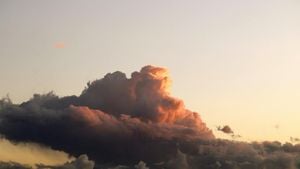Nasa has recently showcased an incredible leap forward in astrophysical research with the introduction of its first full-scale prototype for the Laser Interferometer Space Antenna (LISA) mission. Designed to revolutionize our ability to detect gravitational waves—subtle ripples in the fabric of spacetime caused by cosmic occurrences like colliding black holes—the prototype marks significant progress for both Nasa and the European Space Agency (ESA), who are collaborating on this groundbreaking effort.
The concept of gravitational waves was first proposed by Albert Einstein back in 1915 as part of his general theory of relativity. These waves are generated when massive celestial objects accelerate through space, causing disturbances detectable by sensitive instruments on Earth and beyond. It wasn’t until 2015, almost a century later, when scientists successfully detected these waves using the Laser Interferometer Gravitational-Wave Observatory (LIGO) facilities. The upcoming LISA mission aims to take this groundbreaking research to new heights by positioning three spacecraft within the solar system to form an expansive, triangular configuration measuring nearly 1.6 million miles on each side.
Each spacecraft will be equipped with twin telescopes, both responsible for transmitting and receiving infrared laser beams. These beams will be pivotal for measuring minute distance changes—down to picometers, or trillionths of a meter—between the spacecraft as they orbit the Sun, following Earth's path. This configuration is set to provide unparalleled precision, enhancing the capability to detect gravitational waves from distant cosmic events such as black hole mergers, supernovae, or neutron star collisions.
Ryan DeRosa, a researcher at Nasa’s Goddard Space Flight Center, elaborated on the technology, stating, “Twin telescopes aboard each spacecraft will both transmit and receive infrared laser beams to track their companions. NASA is supplying all six of them to the LISA mission.” The recently unveiled prototype is dubbed the Engineering Development Unit Telescope and will serve as the primary model for developing the equipment needed for actual missions.
Manufactured by L3Harris Technologies, the prototype telescope arrived at Nasa's Goddard Space Flight Center this past May. The design boasts advanced materials technology; its primary mirror, which is coated with gold, improves reflection of the infrared lasers and minimizes heat loss, keeping the telescope near room temperature—even when exposed to the frigidness of space. The telescope's body is constructed from Zerodur, a glass-ceramic known for its remarkable thermal stability. This material allows the telescope to maintain its precision across varying temperatures, minimizing any shape distortion during operation.
With all systems moving forward, LISA's anticipated launch window is projected for the mid-2030s. By leveraging space-based observatories like LISA, scientists expect to significantly advance our knowledge of the universe. According to the mission's official website, the potential findings could yield enormous insights, enhancing our comprehension of cosmic phenomena traditionally studied through other, more limited means.
The LISA mission is nothing short of groundbreaking; it promises unprecedented research capabilities for the study of gravitational waves. These findings could lead to monumental discoveries about some of the universe's most enigmatic events and even aspects of cosmic evolution previously thought elusive.
Gravitational waves are often associated with catastrophic events, yet their detection offers insights beyond mere existence. Unraveling these cosmic disturbances can help clarify foundational aspects of the universe, from stellar evolution to the mechanics behind black holes and possibly even the dynamics of the Big Bang itself.
What sets LISA apart from previous gravitational wave detection efforts is its innovative space-based approach. Unlike LIGO, which operates on Earth, LISA will function within the vacuum of space, presenting less interference and the ability to detect lower-frequency waves. The precursor technology behind LISA will allow for much more sensitive detection capabilities, pushing the limits of current astrophysical research.
This achievement is not just about technological advancement; it’s also about preparing scientists for this new frontier. A successful launch and functioning of the LISA mission could lay down the groundwork for future exploratory missions, helping to provide even more detailed cosmic mapping capabilities and analytical methodologies. With Nasa and ESA teaming up, the stakes are high, and so is the excitement within the scientific community for what lies ahead.
Through LISA's innovative design and methodical approach to gravitational wave detection, researchers may soon have the technology at their disposal to explore uncharted territories of the cosmic unknown. This mission stands to not only advance our theoretical framework of the universe but also engage the world’s populace by deepening our curiosity and appreciation for the cosmos and its underlying mysteries.
With space exploration hitting new milestones, the future of gravitational wave astronomy is bright. LISA could become the key to unlocking many of today’s unanswered questions about the universe, ushering us closer to comprehending phenomena ranging from the origins of black holes to the events leading to the inception of time itself.



